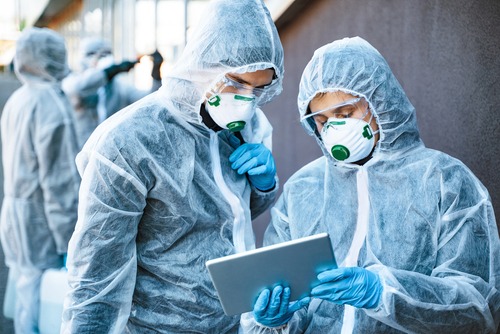
Shortly after the terrorist events of Sept. 11, 2001, letters containing deadly anthrax spores arrived at locations across the country, killing five Americans and sickening 17 others. Twenty years after these incidents, considered the worst biological attacks in U.S. history, the federal government still lacks an effective way to detect for anthrax and other biological agents potentially circulating in the air, according to policymakers across the political spectrum.
In Saving Sisyphus: Advanced Biodetection for the 21st Century, a report released this week by the Bipartisan Commission on Biodefense, the authors write that President George W. Bush understood the need to respond quickly to detect and contain future biological attacks and in 2003 his administration established a national biodetection program called BioWatch. The Department of Homeland Security spends about $80 million a year on this program but the Commission says BioWatch has “questionable accuracy and produces results up to 36 hours after a pathogen may have been present near a detector, long after responders would need to act.”
Thirty-five metropolitan areas have received BioWatch detectors, and DHS also provides them for limited periods for mass gatherings such as the Super Bowl or a presidential national convention. The federal government defines a catastrophic biological attack as an event large enough to cause at least 10,000 casualties.
“Congress cannot continue to justify investing $80 million a year in a program that cannot demonstrate value,” said Commission Co-Chair and former U.S. Secretary of Homeland Security Tom Ridge. “Congress should then invest in a robust, permanent biodetection solution. Policymakers should act immediately to replace this inadequate technology before the next attack occurs.”
The commission suggests an immediate action plan for biodetection, asking that Congress amend the Homeland Security Act of 2002 to direct the Secretary of Homeland Security to:
- Obtain current intelligence and information about the biological threat, redefine the mission of the BioWatch program taking today’s biological threats into consideration, and characterize the environment in which BioWatch detectors will operate within 30 days of enactment.
- Develop new BioWatch program requirements for national biodetection, new technical requirements for biodetection technologies to replace existing BioWatch technology, and new requirements to share results obtained by BioWatch directly with the governors of, and public health departments in, jurisdictions that host the system within 60 days.
- Identify BioWatch replacement technologies and determine where to place detectors and other equipment throughout the nation within 90 days.
- Acquire at least three technologies that can—either individually or together— meet BioWatch mission requirements and the needs of newly identified BioWatch jurisdictions within 180 days.
- Procure and send this newly acquired biodetection technology to BioWatch jurisdictions, test new equipment and laboratory protocols, exercise use, and end old and establish new agreements with public health laboratories in BioWatch jurisdictions to conduct tests and provide other laboratory support within one year.
- Replace old BioWatch equipment, end contracts for laboratory testing, and remove government contractors from public health laboratory facilities within 18 months.
The Commission suggests that within 30 days of the legislation’s change BioWatch should begin collaboration with the HHS Biomedical Advanced Research and Development Authority (BARDA), the Defense Advanced Research Projects Agency (DARPA), and NASA, along with industry and academia.
The report identifies several newer technologies to detect biological agents, including one NASA has developed over the last decade called E-Nose, which mimics canine mechanisms used to detect pathogens such as COVID-19. The technology’s sensor module, connected to a mobile application, can transmit data via a cloud system to emergency operations centers.
Such technology would be a vast improvement to the current detection system, according to the report, as BioWatch experiences high numbers of false positives based on inaccurate results. The current system also requires that personnel monitor every detector each day and bring back filters to the laboratory for testing. Twenty-four hours could lapse before a biological threat is identified. Additionally, the system only detects six known pathogens at a time and is not designed to track emerging infectious diseases.
“The devastating and tumultuous events of 2001 provided a wake-up call to the federal government to take biological threats more seriously,” said former Senate Majority Leader and Commissioner Tom Daschle, himself a recipient of one of the anthrax letters in 2001. “Decisions to establish programs like BioWatch were made with the best of intentions. However, nearly two decades later, no objective analysis of the program’s performance has determined that the technology actually works as intended. Despite the evolution of the biological threat, the Department of Homeland Security never revisited the BioWatch mission, including where and how it should be deployed to provide maximum information and assistance to local jurisdictions. The entire system has languished as the Department marched on with other priorities and the immediate threat of a biological attack faded from view.”
This is not the first time the Commission has expressed concerns about the BioWatch program. In a 2015 report, the organization also suggested the DHS Secretary shut down BioWatch unless new technology showing “valid and reliable results could replace current equipment and procedures.”




